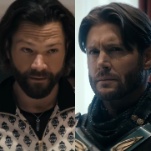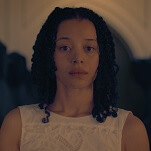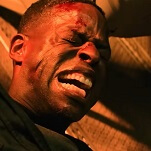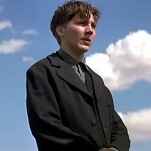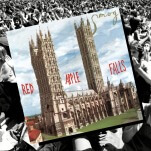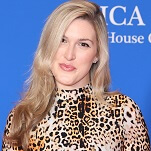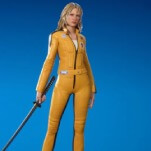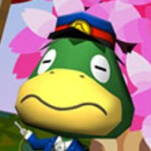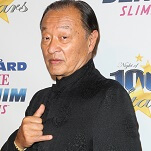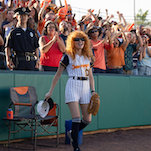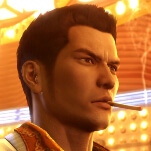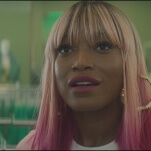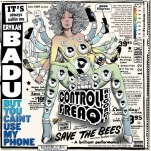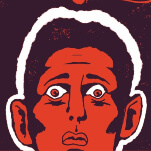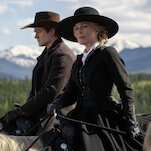Despite being a comic about prehistoric Atlantean pioneers, Undertow #1 (Image) reads as an exceptionally contemporary piece of science fiction, thanks to the work of writer Steve Orlando, artist/colorist Artyom Trakhanov, and letterer/designer Thomas Mauer. The first issue of this new ongoing throws readers headfirst into the conflict between the fascist Atlantis government and Redum Anshargal, leader of a faction of rebel Atlanteans who have sought freedom by breaching the ocean’s surface. Orlando brings a surprisingly modern sensibility to the story through his characterization of Ukinnu Alal, the book’s narrator and point-of-view figure. The child of a wealthy family that planned his entire life for him, Ukinnu enlisted to escape the routine of an office job, club dinners, and an arranged wife and two kids. That desire to break free from the mundane makes him a relatable entry point to this world.
The first page of Undertow shows a single man floating against a white background, an intricately etched image with no color except for the teal triangle behind him and the strange burgundy writing above his head. Is he sinking or rising? Dead or alive? The visual is puzzling and ominous, but also serene, creating a sense of submersion that is reinforced throughout the issue. Trakhanov’s artwork is reminiscent of the artists currently working on Dark Horse’s B.P.R.D. comics, like James Harren and brothers Max and Sebastian Fiumara, with particularly strong talents for rendering a spectrum of textures and using dynamic lighting to create fully realized, immersive atmospheres.
While the B.P.R.D. artists embrace a more gothic aesthetic, the influence of sci-fi and fantasy is stronger here, pushing Trakhanov to create more alien designs while still maintaining a sense of reality that is in line with the more grounded elements of the script. What sets Trakhanov apart most is his intensely varied and vivid coloring, making use of opposing shades to emphasize the dramatically different environments on land and under the sea. The color clash is strongest on the cover, depicting Anshargal punching through forest green water to touch a neon pink sky, and Trakhanov continues to use warm shades of yellow, orange, and red for the earth and cool shades of blue and green for the water within the issue. Every aspect of this first issue is hugely ambitious, and the overwhelming confidence of the storytelling suggests that this is just a fraction of what this creative team has to offer. [OS]
Two months into All-New Marvel Now!, it’s clear that female superheroes are the stars of the publisher’s most recent initiative, with
Black Widow,
Ms. Marvel, and
She-Hulk setting themselves apart with distinct, stylish takes on the women of Marvel Comics. In a brilliant editorial decision, practicing attorney Charles Soule writes
She-Hulk #1 (Marvel), working with artist Javier Pulido, colorist Muntsa Vicente, and letterer Clayton Cowles to give Jennifer Walters a legally charged first issue that wonderfully balances her life as a superhero with her day job as a lawyer. Beyond the first page and a short sequence showing She-Hulk fighting a storage robot, there’s very little action in this introduction, but that doesn’t mean Jennifer’s costumed life isn’t a constant part of the narrative. Rather, it’s folded into her legal career to show that Jennifer is a hero at all times, whether she’s punching out the Wrecking Crew, clocking 2,800 billable hours in a year, or arguing with Tony Stark’s legal team.
Although past volumes of She-Hulk have focused on the title character’s work as an attorney, this newest incarnation goes deeper than ever thanks to Soule’s background. An early scene showing Jennifer’s annual review with her two soon-to-be-former bosses immediately establishes that this is going to be less absurd than the madcap adventures of She-Hulk’s last series, written by Dan Slott, and Soule’s script emphasizes real-world frustrations with the law within the fantastic context.
The writer’s knowledge of both the U.S. legal system and Marvel continuity creates a more cerebral take on the superhero story, best evidenced in the scene where Jennifer meets Legal, Tony Stark’s in-house defense lawyer who speaks in fine print. Legal’s dry, matter-of-fact personality is emphasized by Pulido’s design, which contrasts with Jennifer’s bright, cheerful appearance to show two very different approaches to the law. (For an in-depth analysis of Pulido and Vicente’s artwork, see Big Issues from two weeks ago.) This first issue does everything a first issue should, establishing She-Hulk’s place in the Marvel universe with a self-contained story that sets up an exciting future for the character, and with such a strong foundation, this creative team has the opportunity to build something truly great. [OS]
In the opening pages of Frank J. Barbiere and Toby Cypress’
The White Suits #1 (Dark Horse), a man is shot in the head and a bloody collage of images spews forth from the bullet hole, memories from the victim’s past drenched in the bright red that serves as the primary color for this hard-boiled, hyper-violent tale. It’s an arresting start, both narratively and artistically, setting a gruesome tone while delivering a stunning visual that immediately grabs the reader’s attention with a flash of cryptic information. The images’ meaning is yet to be revealed, but this first issue provides plenty of reasons for readers to find out over the course of the miniseries. Picking up where the short stories published in
Dark Horse Presents last year left off,
The White Suits #1 doesn’t waste much time on exposition, giving readers the basic information they need with a short paragraph of text on the inside cover so that the rest of the issue can focus on ambiance and creating a tense atmosphere.
There are shades of Reservoir Dogs and 100 Bullets in the central idea of a finely dressed group of killers, and while the script has a similarly neo-noir perspective as those two works, it never comes across as a mimic. Much of that is thanks to Cypress’ intensely stylized artwork, which brings remarkable energy and attitude to each panel. Barbiere is economical with his dialogue and narration, giving the artwork the opportunity to do much of the heavy lifting in terms of defining characters and settings. The black-and-white linework shows off Cypress’ astounding inking talent, and the bright flashes of red are a bold design element that provides visual variation while serving as a reminder of the titular group’s origins in communist Russia. The more dramatic the event, the more color Cypress applies to the image, and adding just the tiniest hint of yellow and green to a gunfight makes for a more impactful sequence because of the new hues. Barbiere crafts a captivating story of gangland violence and personal discovery in The White Suits, but it reaches a new level of distinction when paired with Cypress’ innovative work. [OS]
Autobiographical comics about dating troubles are nothing new, but Liz Prince’s
Alone Forever (Top Shelf), a print collection of her webcomics, has so much charm that it breathes new life into well-trodden territory. Prince benefits from being able to view her situation from a distance, so instead of wallowing in self-pity (one of the strips is actually about how her cat won’t allow her to wallow), she finds plenty of material to mine for gags. Prince has no fear of making herself the butt of her own joke—a standout strip is about her attire and degree of personal grooming on a trip out into the world—but none of the humor ever ventures into mean-spirited territory.
Prince’s strips also benefit from the author not limiting herself to focusing on just dates, OKCupid, trying to meet guys at concerts, and being the only single person among couples. She takes her time to breathe, drawing occasional strips in which she simply hangs out with friends. The centerpiece of the book, and a concept that could hold up an entire volume on its own, is a section in which Prince details the progression of a handful of dating relationships she started via OKCupid. These candid portrayals of online dating avoid clichés by showing how people behave in ill-advised ways because they read the exact same experience in wholly different ways. The gags make readers laugh in the moment, but there are insights that stick around long after the book goes back on the shelf. [MDW]
And…
Comic books in 3-D are a gimmick that has never really taken off, but The Joyners In 3D (Archaia) makes a strong case for embracing the third dimension with a sci-fi story that is elevated by 3-D artwork. Writer R.J. Ryan constructs an expansive story that blends a dysfunctional family drama with a corporate thriller in a futuristic setting, and while the plot moves at a brisk pace, the relationships never get fully developed over the course of the book’s 128 pages. The script focuses on the relationship between George Joyner, millionaire tech innovator, and his autistic daughter’s behavioral therapist, Jamie, but there’s a lot of conflict within the Joyner family that doesn’t get much attention. The story would have more emotional impact by delving further into George’s history with his wife, son, and daughter, but the graphic novel is still a highly entertaining read, and David Marquez and Tara Rhymes’ 3-D artwork has a real wow factor. Marquez’s slick black-and-white linework is tailored to the format, and the artist understands that details will get lost in the blur of the 3-D effect so he uses a more simplified animated style. The added depth creates some breathtaking vistas, and Archaia wisely includes two pairs of 3-D glasses so that readers can share the experience with a friend… [OS]
The names are changed, but Milan K Part One: The Teenage Years (Humanoids), the new graphic novel from writer Sam Timel and artist Corentin, clearly draws its inspiration from the story of Russian oil tycoon Mikhail Khodorkovsky, who was imprisoned in 2003 under orders from President Vladimir Putin. Khodorkovsky was eventually released and reunited with his family (and some of his wealth) in 2013, but Milan K takes a “What If?” approach to the story, envisioning what might have happened if an attack on the tycoon’s family, here named Khodorov, successfully killed everyone except one tenacious son. What results is a story of industrial espionage and political gamesmanship that maintains a level of admirable tension. Comics have often avoided stories that focus solely on politics and business because talky scenes in offices don’t titillate, but Corentin figures out a way to make it all work so that scenes of the lead character racing to a plane or talking to someone on a cell phone end up being page-turners. The artwork isn’t flashy, except when it comes to Milan’s hair, but it does a great job of keeping the reader interested in a potentially confusing story about stock buyouts and ownership. The end of the story is full-on wish fulfillment, and it leaves Milan with few goals left to achieve in future volumes, but as it stands, the first graphic novel in the series holds up well… [MDW]
In the black-and-white world of Diane Obamsawin’s On Loving Women (Drawn And Quarterly), uniformity is the governing philosophy: Humans are replaced by homogeneous anthropomorphic animals, streets are lined with identical houses, an orphanage is filled with rows of the same beds next to the same nightstands that all have the same bowls resting atop them. That standardized setting is essential to capturing the feeling of otherness experienced by the lesbian women of Obamsawin’s short stories, who share their stories of sexual discovery and learning to accept what makes them different. These protagonists tend to have some sort of visual indicator to offset that otherness, whether it’s a drastic contrast, like Catherine being a bird in a classroom of bulls, or something subtler like Diane being the one girl who wears slacks when everyone else wears skirts. Their stories are tender, heartbreaking, and often hilarious, and the stark, simplified art style allows for maximum expression with minimal flourish. Obamsawin realizes these narratives with touching honesty, using a cast of animal characters to show deeply human portrayals of same-sex love and individual self-discovery… [OS]
The titular dinosaurs don’t show up until more than halfway through Turok: Dinosaur Hunter #1 (Dynamite), a revival of the classic Gold Key Comics character that most readers likely became familiar with via the series of video games for Nintendo 64. Writer Greg Pak uses the early pages of the book to establish more about Turok as a character than those games did in their entirety. He’s a prisoner in his own home, captured in his youth after the local tribe killed his parents, who seem to be somewhat mysterious, nomadic warriors. Pak and artist Mirko Colak, whose occasionally muddy art excels at building a sense of mystery, largely set up intrigue before throwing raptors into the mix, and the creatures are welcome when they show up, as the tribal politics of the early pages eventually become a bit tedious. Luckily, the series promises a much different direction after the dinosaurs’ arrival and the reveal of their surprising handlers. [MDW]




